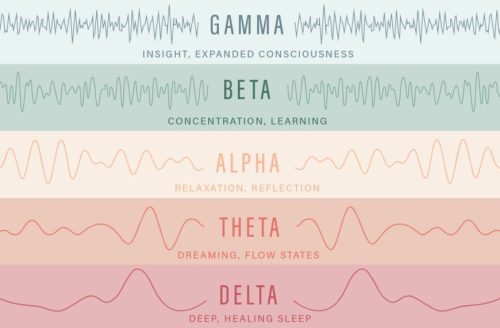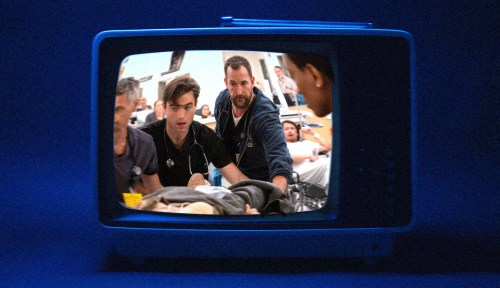Our editors independently select these products. Making a purchase through our links may earn Well+Good a commission
If I could have any superpower—aside from the ability to jeté like Misty Copeland—it’d be mind control. Not only would it be cool to telepathically convince the Sweetgreen staffers to put extra (free) avocado on my salad, but it’d also be a dream to have full authority over my own unruly brain—to adopt whatever mental state I need, exactly when I need it. You know, creative and insightful during at-work hours, meditative and serene at yoga, sharp-witted and sparkly while I’m on a date.
That’s because, for me, the reality is usually a lot different. More often than not, my mind and my schedule are wildly out of sync and I feel like I can’t do anything about it—I’m dreamy and distracted while on deadline or frantically overanalyzing a past conversation when everyone else is snoozing in pigeon pose.
But it appears as though my fantasies of reining in my rebellious psyche may not be so far-fetched, given all the discussion about brainwave manipulation in the biohacking and mindfulness communities. The gist: By learning more about the electromagnetic patterns your brain habitually exhibits on a day-to-day basis—all of which are generally linked with a certain state of mind—there’s the belief that you’d be able to take certain steps to optimize them for greater peace, productivity, and general wellbeing.
“Brainwave training is a relatively new research area, but more and more labs are interested in understanding brainwaves and how they relate to a whole plethora of behaviors—from managing stress to full-blown spiritual awakenings,” says Leigh Winters, MS, a neuroscientist and former fellow at Columbia University’s Spirituality Mind Body Institute.
“More and more labs are interested in understanding brainwaves and how they relate to a whole plethora of behaviors—from managing stress to full-blown spiritual awakenings.”
Brainwaves are making a splash outside of academia, too. We’re seeing it in the form of consumer-friendly headbands like those from Muse, Neurosky, and Emotiv that give you feedback on your brain’s activity and, in some cases, help you shift your state through meditation and brain-training games. If you’ve got $15,000 to spare, you can embark upon Bulletproof founder Dave Asprey’s 40 Years of Zen program. With the help of high-powered neurofeedback devices, students learn how to biohack the same brain patterns as an advanced Zen meditator in just 5 days. And it’s even coasting into fitness territory—Megaformer pioneer Sebastien Lagree is working on a mind-controlled version of his new Supraformer machine (yes, really). He envisions a day in which users will be able to direct the equipment’s movements through a biofeedback headband and brainwave-reading software.
But are there any ways to hack your brainwaves that don’t require a major outlay of cash or specialized gear? I asked Winters to give me a primer in brainwaves and how to train them, in hopes that she could reveal the trick to summoning a sense of focus, calm, or inspiration on demand.
Read on for a primer on the types of brainwaves and how to train yourself to tap into them.

What are brainwaves, anyway?
Contrary to what you might think, brainwaves aren’t a physical thing—they’re a measurement of activity that’s going on within your brain.
“The brain is an electrochemical organ, meaning that if you hooked up enough wires to your scalp, you might be able to power a light bulb,” explains Winters. “This electrical communication happens through neurons, which are specialized brain cells that are responsible for transmitting information through the body in both chemical and electrical forms. And the electrical activity that emanates from these neurons communicating is measured in the form of brainwaves.”
Up until recently, brainwave measurement was pretty much restricted to a medical or lab setting, as it requires tools like electroencephalography (EEG)—whereby sensors attached to the scalp “read” the brainwaves, similar to how your heart-rate monitor reads your pulse—or neuroimaging, which scans the bran using magnetic resonance imaging (MRI) or other technology. (Kinda like an aura photo for your noggin.) But, as mentioned before, devices like the Muse headband or Emotiv Insight tracker allow you to get a read on your brainwaves at home, although Winters says they’re not nearly as advanced as the ones used clinically.
“Unfortunately, most of the popular wearables on the market are not 100-percent accurate in their sensing capabilities, which can lead to false data,” she says. Even so, she’s a fan of them. “There is benefit to tracking your brainwave readings, even if you’re just getting a general idea of your activity. Any progress to get people more mindful about how their mental state affects their overall wellbeing is a step in the right direction.”

The 5 types of brainwaves
Now here’s where it gets fun: Brainwaves are grouped into five distinct categories, each of which is associated with a very specific type of task and mental state.
The most high-frequency—and, some may say, high-vibe—of the bunch are gamma waves. “Gamma waves are often associated with insight, peak focus, and expanded consciousness,” says Winters. “These waves are generated when the brain is learning new information, sharply concentrating, or storing memories.” She adds that this “hyper-focused, tranquil attention” is characteristic of Zen meditators and master musicians.
A step down are beta waves, which is what most of us experience most of the time in our always-on society. “Their upside is that they allow us to concentrate hard on tasks at hand—and they’re critical when we read, write, and socialize,” says Winters. (It’s the frequency of the hustle, basically.) “The downside of beta waves is that they can zap our energy and reduce emotional awareness and creativity.”
Once we get home at the end of the day, if we’re lucky, we shift into a relaxed, reflective alpha wave pattern. “If you daydream, wind down for bed, or sit down with a good book, your brain is likely in an alpha state,” says Winters. On the other hand, if your brain has trouble shifting from beta to alpha—a stress-induced phenomenon called “alpha blocking”—you could suffer from insomnia, anxiety, or obsessive-compulsive symptoms, says Winters.
Finally, once you fall asleep, you experience theta waves (the ones associated with dreaming) and delta waves (which promote deep, restorative, dreamless slumber.) Interestingly, theta waves are also linked with being in that elusive, hypnotic flow state associated with peak performance, as well as the autopilot mode we shift into when we’re doing something we’ve done a million times before, like driving home from work on a familiar route. “[People can] have flashes of insight or bursts of creativity when in these flow states because their behaviors are often so automatic that they can mentally disengage and just be,” explains Winters. So that explains why I have all my best ideas in the shower…

How to manipulate your brainwaves
There’s actually a very simple way to change your brainwaves to feel more centered and less stressed: Meditation. (Which is why you’ve likely heard your yoga instructor talking about brainwaves while you’re deep in savasana.)
“Regular meditation has been found to increase alpha activity and decrease beta in waking states,” says Winters, who notes that shorter, “beginner” meditations are associated with alpha waves. “It’s also been demonstrated to enhance gamma wave states, which makes sense because gamma is thought to increase awareness and make us very in tune with ourselves and our environment.” (Think of this as more of an advanced meditation goal.)
If you want to cultivate a certain type of brainwave while engaging in a certain kind of task—like tapping into alpha waves if you can’t sleep, or that theta flow vibe while running—Winters suggests listening to binaural beats, which are looping sounds that promote specific brainwave states. You can find them on Youtube or Spotify by searching for the type of brainwave you’re after, like “theta binaural beats.” (I’ve tried this, and can attest that it definitely helps me get into the zone when I’m facing a blank Word document on my computer.) Brain.fm is another option, which features actual music to enhance focus, relaxation, or meditation.
And for more data-driven, targeted training, Winters recommends working with a neurofeedback coach who uses measurement tools like EEG to tell you exactly which states you’re currently in and work with you to change them.
“Anyone can ‘train’ their body and brain to access these mental states—it just takes some dedicated and repeated practice,” says Winters. Looks like mind control isn’t just the stuff of sci-fi blockbusters, after all.
Biohacking is one of the biggest women’s wellness trends of 2018—get started with these life-changing health tips and 6 habits that’ll further hack your brain power.
Sign Up for Our Daily Newsletter
Get all the latest in wellness, trends, food, fitness, beauty, and more delivered right to your inbox.
Got it, you've been added to our email list.











